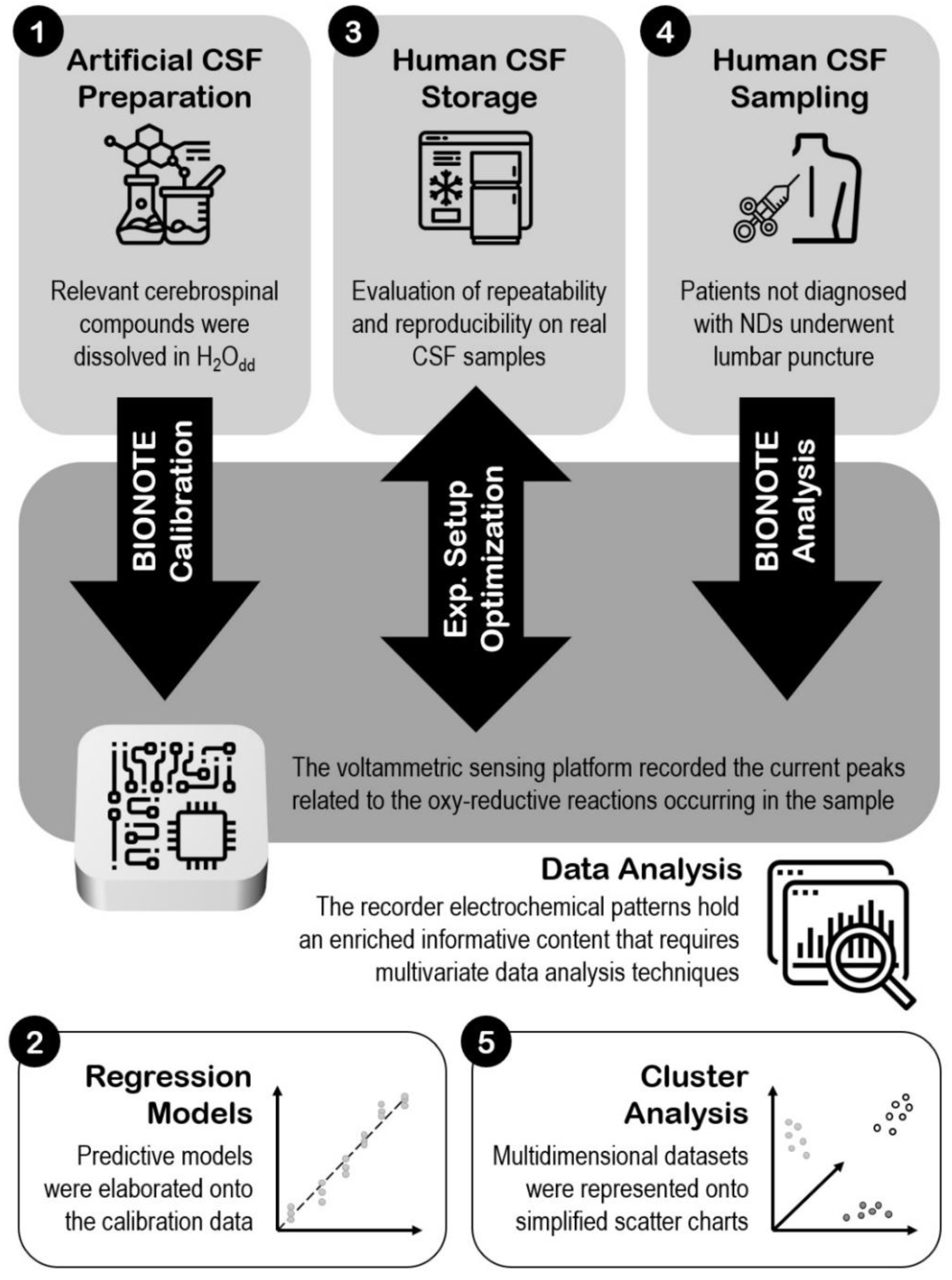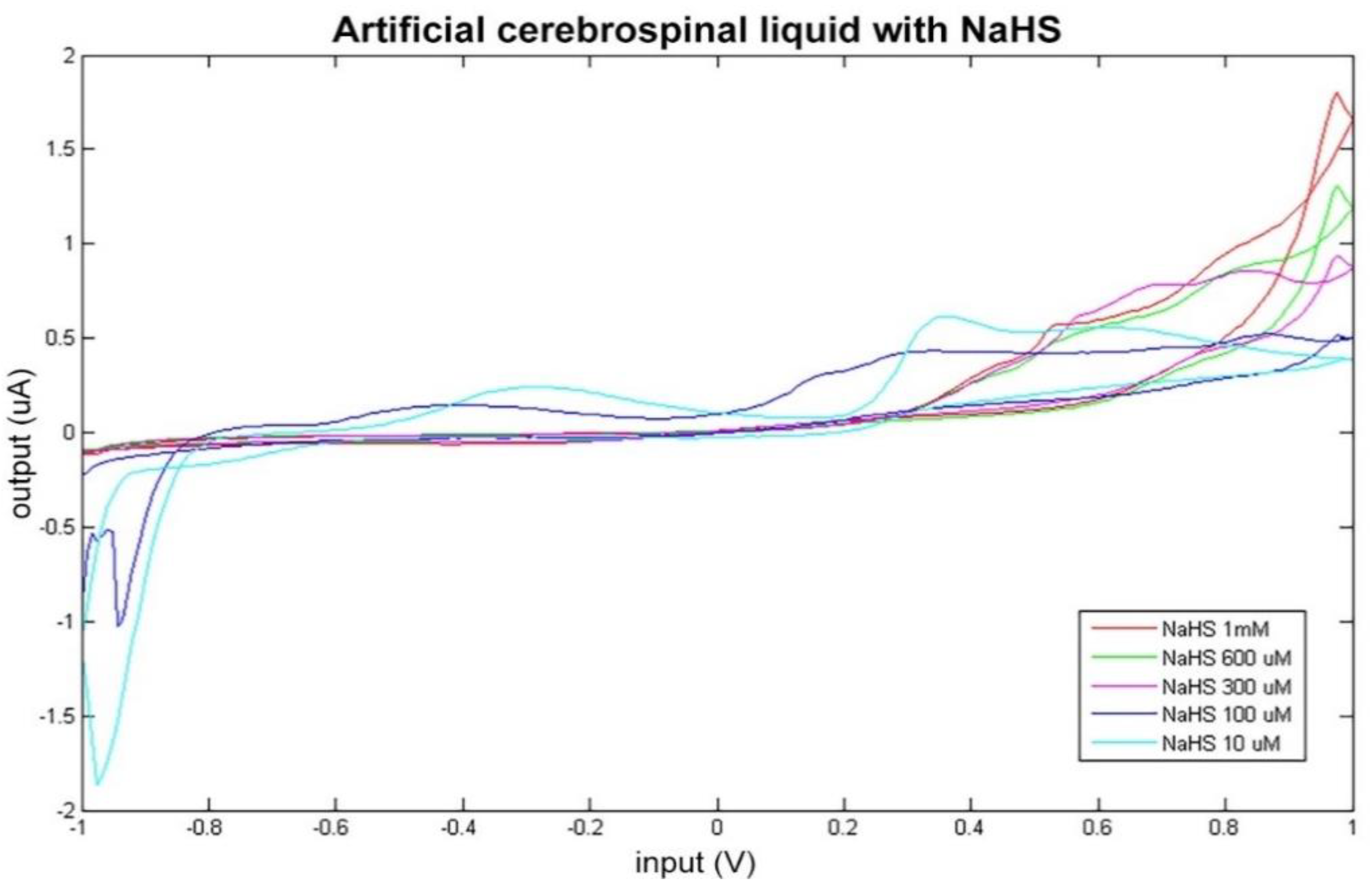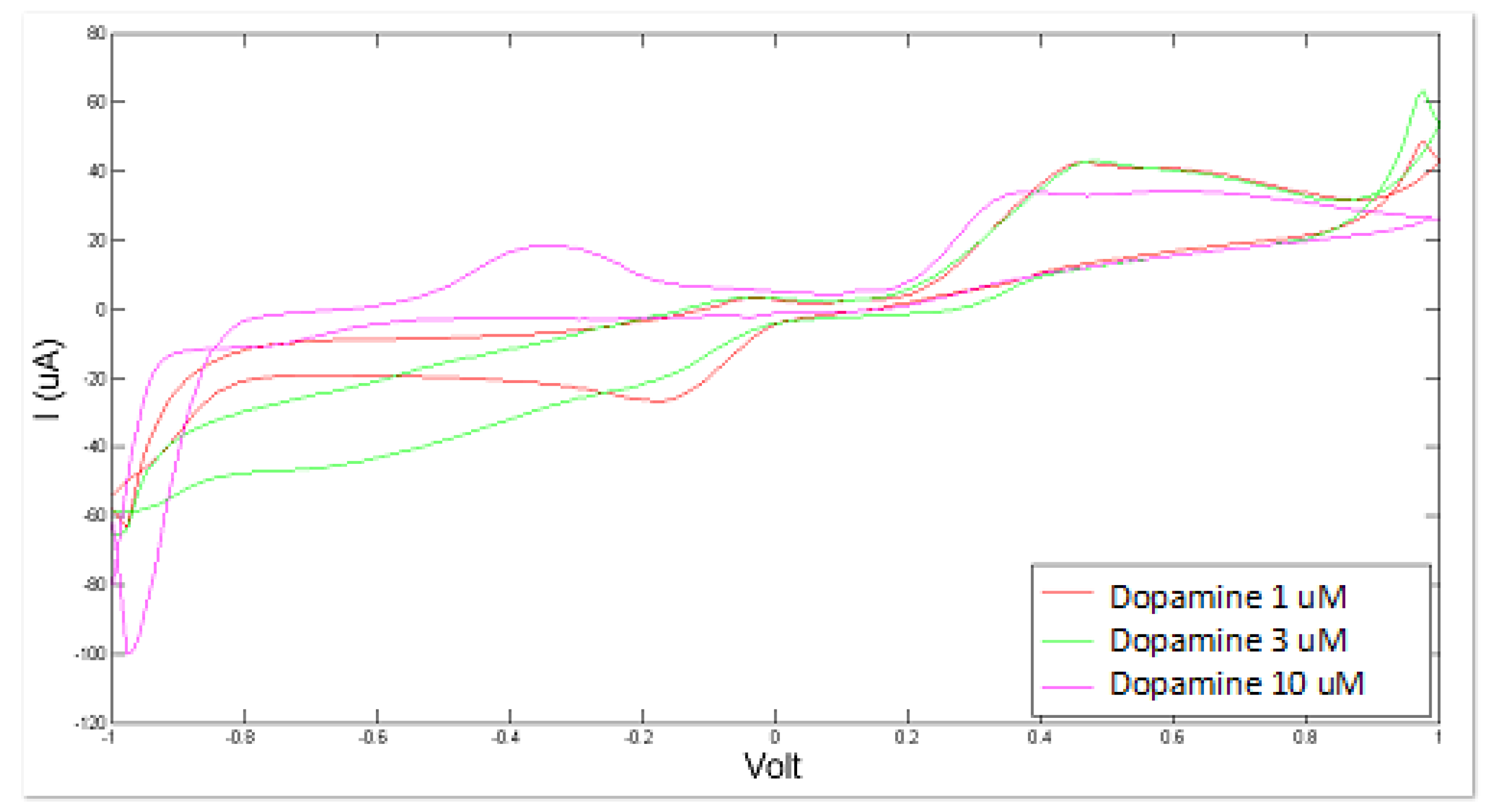Design of an Innovative Methodology for Cerebrospinal Fluid Analysis: Preliminary Results
Abstract
1. Introduction
2. Materials and Methods
2.1. Voltammetric System and Experimental Design
2.2. Preparation of the Standard Curves for Calibration Purposes
2.3. Preparation of the Artificial Cerebrospinal Fluid (CSF)
2.4. Human CSF Sampling
2.5. Data Analysis
3. Results
3.1. Calibration of the BIONOTE (Biosensor-Based Multisensorial System for Mimicking Nose, Tongue and Eyes) to the Single Artificial CSF Constituents
3.2. Measurements of Artificial CSF and Their Modifications
3.3. Optimization of the Experimental Setup for Human CSF Analysis
3.4. Preliminary Tests on Human CSF Samples
4. Discussion
5. Conclusions
Author Contributions
Funding
Institutional Review Board Statement
Informed Consent Statement
Data Availability Statement
Conflicts of Interest
References
- Schirinzi, T.; Canevelli, M.; Suppa, A.; Bologna, M.; Marsili, L. The continuum between neurodegeneration, brain plasticity, and movement: A critical appraisal. Rev. Neurosci. 2020. [Google Scholar] [CrossRef]
- Lang, A.E.; Espay, A.J. Disease modification in Parkinson’s disease: Current approaches, challenges, and future considerations. Mov. Disord. 2018, 33, 660–677. [Google Scholar] [CrossRef]
- Jack, C.R.; Bennett, D.A.; Blennow, K.; Carrillo, M.C.; Dunn, B.; Haeberlein, S.B.; Holtzman, D.M.; Jagust, W.; Jessen, F.; Karlawish, J.; et al. NIA-AA research framework: Toward a biological definition of Alzheimer’s disease. Alzheimer’s Dement 2018, 14, 535–562. [Google Scholar] [CrossRef]
- Schirinzi, T.; Sancesario, G.M.; Di Lazzaro, G.; Biticchi, B.; Colona, V.L.; Mercuri, N.B.; Bernardini, S.; Pisani, A. CSF α-synuclein inversely correlates with non-motor symptoms in a cohort of PD patients. Parkinsonism Relat. Disord. 2018. [Google Scholar] [CrossRef]
- Schirinzi, T.; Di Lazzaro, G.; Sancesario, G.M.; Summa, S.; Petrucci, S.; Colona, V.L.; Bernardini, S.; Pierantozzi, M.; Stefani, A.; Mercuri, N.B.; et al. Young-onset and late-onset Parkinson’s disease exhibit a different profile of fluid biomarkers and clinical features. Neurobiol. Aging 2020, 90, 119–124. [Google Scholar] [CrossRef]
- Schirinzi, T.; Sancesario, G.M.; Di Lazzaro, G.; Scalise, S.; Colona, V.L.; Imbriani, P.; Mercuri, N.B.; Bernardini, S.; Lang, A.E.; Pisani, A. Clinical value of CSF amyloid-beta-42 and tau proteins in progressive supranuclear palsy. J. Neural Transm. 2018. [Google Scholar] [CrossRef]
- Teunissen, C.E.; Otto, M.; Engelborghs, S.; Herukka, S.-K.; Lehmann, S.; Lewczuk, P.; Lleó, A.; Perret-Liaudet, A.; Tumani, H.; Turner, M.R.; et al. White paper by the society for CSF analysis and clinical neurochemistry: Overcoming barriers in biomarker development and clinical translation. Alzheimers. Res. Ther. 2018, 10, 30. [Google Scholar] [CrossRef]
- Pennazza, G.; Santonico, M.; Vollero, L.; Zompanti, A.; Sabatini, A.; Kumar, N.; Pini, I.; Solano, W.F.Q.; Sarro, L.; D’Amico, A. Advances in the electronics for cyclic voltammetry: The case of gas detection by using microfabricated electrodes. Front. Chem. 2018, 6. [Google Scholar] [CrossRef] [PubMed]
- Santonico, M.; Pennazza, G.; Grasso, S.; D’Amico, A.; Bizzarri, M. Design and test of a Biosensor-based multisensorial system: A proof of concept study. Sensors 2013, 13, 16625–16640. [Google Scholar] [CrossRef] [PubMed]
- Pipita, M.E.; Santonico, M.; Pennazza, G.; Zompanti, A.; Fazzina, S.; Cavalieri, D.; Bruno, F.; Angeletti, S.; Pedone, C.; Incalzi, R.A. Integration of voltammetric analysis, protein electrophoresis and pH measurement for diagnosis of pleural effusions: A non-conventional diagnostic approach. Sci. Rep. 2020, 10. [Google Scholar] [CrossRef]
- Muley, M.; Vespasiani-Gentilucci, U.; de Vincentis, A.; Santonico, M.; Pennazza, G.; Sanguedolce, S.; de Luca, C.; Plotti, F.; Picardi, A.; Antonelli-Incalzi, R. Voltammetric analysis for distinguishing portal hypertension-related from malignancy-related ascites: A proof of concept study. PLoS ONE 2020, 15, e0233350. [Google Scholar] [CrossRef]
- Lelli, D.; Pedone, C.; Frezzotti, E.; Pennazza, G.; Santonico, M.; Grasso, S.; Antonelli Incalzi, R. Use of voltammetric analysis for fast and objective discrimination of the etiology, evolution, and bacterial infection of lower limb ulcers. Wound Repair Regen. 2019, 27, 288–291. [Google Scholar] [CrossRef]
- Lelli, D.; Pedone, C.; Alemanno, P.; Bertini, A.; Di Gioia, C.; Fazzina, S.; Pennazza, G.; Santonico, M.; Grasso, S.; Zompanti, A.; et al. Voltammetric analysis for fast and inexpensive diagnosis of urinary tract infection: A diagnostic study. J. Transl. Med. 2018, 16. [Google Scholar] [CrossRef] [PubMed]
- Chan, H.N.; Xu, D.; Ho, S.L.; He, D.; Wong, M.S.; Li, H.W. Highly sensitive quantification of Alzheimer’s disease biomarkers by aptamer-assisted amplification. Theranostics 2019, 9, 2939. [Google Scholar] [CrossRef]
- Song, C.; Deng, P.; Que, L. Rapid multiplexed detection of beta-amyloid and total-tau as biomarkers for Alzheimer’s disease in cerebrospinal fluid. Nanomed. Nanotechnol. Biol. Med. 2018, 14, 1845–1852. [Google Scholar] [CrossRef]
- García-Chamé, M.Á.; Gutiérrez-Sanz, Ó.; Ercan-Herbst, E.; Haustein, N.; Filipiak, M.S.; Ehrnhöfer, D.E.; Tarasov, A. A transistor-based label-free immunosensor for rapid detection of tau protein. Biosens. Bioelectron. 2020, 159, 112129. [Google Scholar] [CrossRef]
- Vestergaard, M.d.; Kerman, K.; Saito, M.; Nagatani, N.; Takamura, Y.; Tamiya, E. A rapid label-free electrochemical detection and kinetic study of alzheimer’s amyloid beta aggregation. J. Am. Chem. Soc. 2005, 127, 11892–11893. [Google Scholar] [CrossRef]
- Dawe, G.S.; Han, S.P.; Bian, J.S.; Moore, P.K. Hydrogen sulphide in the hypothalamus causes an ATP-sensitive K+ channel-dependent decrease in blood pressure in freely moving rats. Neuroscience 2008, 152, 169–177. [Google Scholar] [CrossRef] [PubMed]
- Thomas, A.; Kumar, K.G. Communication—Electrooxidation of dopamine at CoNP-pAHNSA modified electrode: A sensitive approach to its determination. J. Electrochem. Soc. 2018, 165, B466–B468. [Google Scholar] [CrossRef]
- Davoli, A.; Greco, V.; Spalloni, A.; Guatteo, E.; Neri, C.; Rizzo, G.R.; Cordella, A.; Romigi, A.; Cortese, C.; Bernardini, S.; et al. Evidence of hydrogen sulfide involvement in amyotrophic lateral sclerosis. Ann. Neurol. 2015, 77, 697–709. [Google Scholar] [CrossRef] [PubMed]
- Schirinzi, T.; Sancesario, G.M.; Ialongo, C.; Imbriani, P.; Madeo, G.; Toniolo, S.; Martorana, A.; Pisani, A. A clinical and biochemical analysis in the differential diagnosis of idiopathic normal pressure hydrocephalus. Front. Neurol. 2015, 6, 86. [Google Scholar] [CrossRef] [PubMed]
- Di Natale, C.; Martinelli, E.; Pennazza, G.; Orsini, A.; Santonico, M. Data analysis for chemical sensor arrays. NATO Secur. Sci. Ser. A Chem. Biol. 2006, 147–169. [Google Scholar] [CrossRef]
- Schirinzi, T.; Di Lorenzo, F.; Sancesario, G.M.; Di Lazzaro, G.; Ponzo, V.; Pisani, A.; Mercuri, N.B.; Koch, G.; Martorana, A. Amyloid-mediated cholinergic dysfunction in motor impairment related to Alzheimer’s disease. J. Alzheimer’s Dis. 2018, 64, 525–532. [Google Scholar] [CrossRef] [PubMed]
- Albanese, M.; Placidi, F.; Romigi, A.; Schirinzi, T.; Liguori, C.; Marchi, A.; Garaci, F.; Floris, R.; Mercuri, N.B.; Marciani, M.G.; et al. Symptomatic nonconvulsive status epilepticus erroneously suggestive of sporadic Creutzfeldt-Jakob disease. J. Neurol. Sci. 2015, 348, 274–276. [Google Scholar] [CrossRef][Green Version]
- Forlenza, O.V.; Radanovic, M.; Talib, L.L.; Aprahamian, I.; Diniz, B.S.; Zetterberg, H.; Gattaz, W.F. Cerebrospinal fluid biomarkers in Alzheimer’s disease: Diagnostic accuracy and prediction of dementia. Alzheimer’s Dement. Diagn. Assess. Dis. Monit. 2015, 1, 455–463. [Google Scholar] [CrossRef] [PubMed]
- Schirinzi, T.; Di Lazzaro, G.; Sancesario, G.M.; Colona, V.L.; Scaricamazza, E.; Mercuri, N.B.; Martorana, A.; Sancesario, G. Levels of amyloid-beta-42 and CSF pressure are directly related in patients with Alzheimer’s disease. J. Neural Transm. 2017. [Google Scholar] [CrossRef]








| Chemical Standard Concentration (mM) | |||||||
|---|---|---|---|---|---|---|---|
| KCl | 3 | 10 | 50 | 100 | 150 | ||
| NaCl | 10 | 50 | 100 | 124 | 150 | ||
| NaHCO3 | 10 | 25 | 50 | 100 | 150 | ||
| CaCl2 | 2 | 10 | 50 | 100 | 150 | ||
| MgCl2 | 1 | 10 | 50 | 100 | 150 | ||
| NaHS | 0.01 | 0.1 | 0.3 | 0.6 | 1 | ||
| Dopamine | 0.001 | 0.003 | 0.01 | ||||
| KCl | NaCl | NaHCO3 | CaCl2 | MgCl2 | NaHS | |
|---|---|---|---|---|---|---|
| mM | 3 | 124 | 26 | 2 | 1 | 1.25 |
| Chemical Standard Concentration (mM) | |||||
|---|---|---|---|---|---|
| NaHS | 0.01 | 0.1 | 0.3 | 0.6 | 1 |
| Dopamine | 0.001 | 0.003 | 0.005 | 0.007 | 0.01 |
| Variable | Mean | st.dev. |
|---|---|---|
| Age (years) | 62 | 13.8 |
| Glucose (mg/dL) | 57.1 | 4.7 |
| Lactate (mmol/L) | 1.8 | 0.2 |
| Total proteins (mg/dL) | 48.3 | 19.4 |
| Albumin (mg/dL) | 28.4 | 16.1 |
| White blood cells (mmc) | 3.1 | 2.4 |
| Immunoglobulin-G (mg/dL) | 5.7 | 7.6 |
| Amyloid-β-42 (pg/mL) | 715.4 | 378.8 |
| Total-tau (pg/mL) | 340.3 | 165.9 |
| Phosphorylated-181-tau (pg/mL) | 83 | 96.1 |
| KCl | NaCl | NaHCO3 | CaCl2 | MgCl2 | NaHS | Dopamine | |
|---|---|---|---|---|---|---|---|
| RMSEC | 3.62 | 1.39 | 0.09 | 0.43 | 0.13 | 0.84 × 10−2 | 0.02 × 10−3 |
| RMSECV | 9.69 | 11.01 | 8.01 | 8.66 | 7.89 | 9.26 × 10−2 | 1.80 × 10−3 |
| RMSEC | RMSECV | |
|---|---|---|
| Glucose (mg/dL) | 0.15 | 4.28 |
| Lactate (mmol/L) | 0.18 | 0.29 |
| Total proteins (mg/dL) | 0.37 | 19.93 |
| Albumin (mg/dL) | 0.76 | 16.53 |
| White blood cells (mmc) | 0.69 | 2.53 |
| Immunoglobulin-G (mg/dL) | 0.62 | 2.21 |
| Amyloid-β-42(pg/mL) | 275.21 | 510.25 |
| Total-tau (pg/mL) | 0.90 | 176.39 |
| Phosphorylated-181-tau (pg/mL) | 30.19 | 120.94 |
Publisher’s Note: MDPI stays neutral with regard to jurisdictional claims in published maps and institutional affiliations. |
© 2021 by the authors. Licensee MDPI, Basel, Switzerland. This article is an open access article distributed under the terms and conditions of the Creative Commons Attribution (CC BY) license (https://creativecommons.org/licenses/by/4.0/).
Share and Cite
Schirinzi, T.; Cordella, A.; Mercuri, N.B.; D’Amico, A.; Palombi, A.; Zompanti, A.; Grasso, S.; Pennazza, G.; Santonico, M. Design of an Innovative Methodology for Cerebrospinal Fluid Analysis: Preliminary Results. Sensors 2021, 21, 3767. https://doi.org/10.3390/s21113767
Schirinzi T, Cordella A, Mercuri NB, D’Amico A, Palombi A, Zompanti A, Grasso S, Pennazza G, Santonico M. Design of an Innovative Methodology for Cerebrospinal Fluid Analysis: Preliminary Results. Sensors. 2021; 21(11):3767. https://doi.org/10.3390/s21113767
Chicago/Turabian StyleSchirinzi, Tommaso, Alberto Cordella, Nicola Biagio Mercuri, Arnaldo D’Amico, Andrea Palombi, Alessandro Zompanti, Simone Grasso, Giorgio Pennazza, and Marco Santonico. 2021. "Design of an Innovative Methodology for Cerebrospinal Fluid Analysis: Preliminary Results" Sensors 21, no. 11: 3767. https://doi.org/10.3390/s21113767
APA StyleSchirinzi, T., Cordella, A., Mercuri, N. B., D’Amico, A., Palombi, A., Zompanti, A., Grasso, S., Pennazza, G., & Santonico, M. (2021). Design of an Innovative Methodology for Cerebrospinal Fluid Analysis: Preliminary Results. Sensors, 21(11), 3767. https://doi.org/10.3390/s21113767










